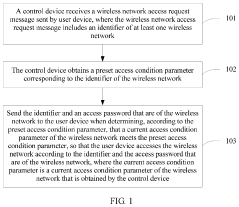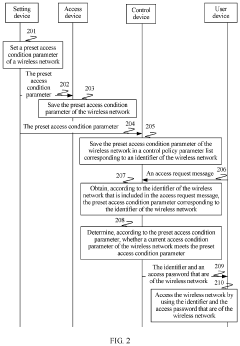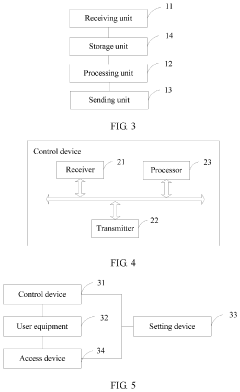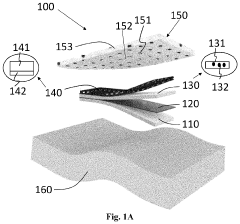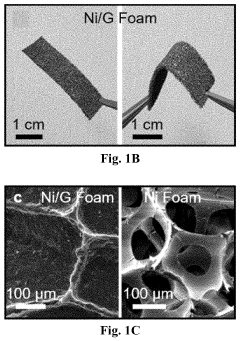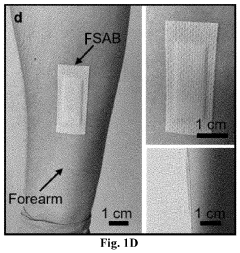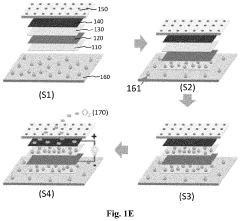Cellophane in Wearable Technology: A Future Outlook
JUL 9, 20259 MIN READ
Generate Your Research Report Instantly with AI Agent
Patsnap Eureka helps you evaluate technical feasibility & market potential.
Cellophane Tech Evolution
Cellophane, a transparent sheet made from regenerated cellulose, has undergone significant technological evolution since its invention in 1908. Initially developed as a waterproof coating for tablecloths, cellophane's journey in the realm of wearable technology has been marked by continuous innovation and adaptation.
In the early stages, cellophane's use in wearables was limited due to its rigid nature and lack of flexibility. However, advancements in material science during the mid-20th century led to the development of more pliable forms of cellophane, opening up new possibilities for its application in clothing and accessories.
The 1960s and 1970s saw the first experimental uses of cellophane in fashion, primarily as a decorative element. Designers explored its transparent and reflective properties to create avant-garde pieces, but its practical applications in everyday wearables remained limited.
A significant breakthrough came in the 1980s with the development of micro-perforated cellophane. This innovation allowed for better breathability and comfort, making it more suitable for incorporation into clothing. Concurrently, advancements in adhesive technologies enabled better integration of cellophane with traditional textiles.
The turn of the millennium marked a new era for cellophane in wearable technology. Researchers began exploring its potential as a substrate for flexible electronics. The material's transparency and ability to be produced in ultra-thin sheets made it an attractive option for creating see-through displays and sensors.
In the past decade, the focus has shifted towards enhancing cellophane's properties for specific wearable applications. Efforts have been made to improve its durability, stretchability, and conductivity. Nano-coating techniques have been developed to imbue cellophane with additional functionalities such as water-repellency and antimicrobial properties.
Recent advancements have also explored the integration of cellophane with other materials to create hybrid composites. These composites aim to combine the best properties of cellophane - such as transparency and biodegradability - with the strengths of other materials like enhanced durability or electronic capabilities.
Looking towards the future, research is now focusing on developing "smart" cellophane that can change properties in response to environmental stimuli. This could lead to wearable technologies that adapt to the wearer's needs, such as clothing that adjusts its insulation based on temperature or changes color for camouflage or fashion purposes.
In the early stages, cellophane's use in wearables was limited due to its rigid nature and lack of flexibility. However, advancements in material science during the mid-20th century led to the development of more pliable forms of cellophane, opening up new possibilities for its application in clothing and accessories.
The 1960s and 1970s saw the first experimental uses of cellophane in fashion, primarily as a decorative element. Designers explored its transparent and reflective properties to create avant-garde pieces, but its practical applications in everyday wearables remained limited.
A significant breakthrough came in the 1980s with the development of micro-perforated cellophane. This innovation allowed for better breathability and comfort, making it more suitable for incorporation into clothing. Concurrently, advancements in adhesive technologies enabled better integration of cellophane with traditional textiles.
The turn of the millennium marked a new era for cellophane in wearable technology. Researchers began exploring its potential as a substrate for flexible electronics. The material's transparency and ability to be produced in ultra-thin sheets made it an attractive option for creating see-through displays and sensors.
In the past decade, the focus has shifted towards enhancing cellophane's properties for specific wearable applications. Efforts have been made to improve its durability, stretchability, and conductivity. Nano-coating techniques have been developed to imbue cellophane with additional functionalities such as water-repellency and antimicrobial properties.
Recent advancements have also explored the integration of cellophane with other materials to create hybrid composites. These composites aim to combine the best properties of cellophane - such as transparency and biodegradability - with the strengths of other materials like enhanced durability or electronic capabilities.
Looking towards the future, research is now focusing on developing "smart" cellophane that can change properties in response to environmental stimuli. This could lead to wearable technologies that adapt to the wearer's needs, such as clothing that adjusts its insulation based on temperature or changes color for camouflage or fashion purposes.
Wearable Market Demand
The wearable technology market has experienced significant growth in recent years, driven by increasing consumer demand for smart devices that seamlessly integrate into daily life. This trend is expected to continue, with the global wearable technology market projected to reach substantial value in the coming years. The adoption of wearable devices spans various sectors, including healthcare, fitness, entertainment, and enterprise applications.
In the healthcare sector, wearable devices are revolutionizing patient monitoring and preventive care. Consumers are increasingly interested in devices that can track vital signs, monitor chronic conditions, and provide real-time health data to healthcare providers. This demand is fueled by the growing emphasis on personalized medicine and the need for continuous health monitoring outside traditional clinical settings.
The fitness and wellness segment remains a strong driver of wearable technology adoption. Consumers are seeking devices that can track physical activity, monitor sleep patterns, and provide insights into overall well-being. The integration of advanced sensors and AI-powered analytics in wearable devices is meeting this demand by offering more accurate and comprehensive health and fitness data.
Enterprise applications of wearable technology are also on the rise. Industries such as manufacturing, logistics, and field services are adopting wearable devices to improve worker productivity, safety, and efficiency. There is a growing demand for hands-free devices that can provide real-time information, facilitate communication, and enhance situational awareness in various work environments.
The entertainment and gaming sectors are exploring new frontiers in wearable technology, with increasing interest in augmented reality (AR) and virtual reality (VR) devices. Consumers are showing enthusiasm for immersive experiences that blend digital content with the physical world, driving demand for lightweight, comfortable, and high-performance wearable displays.
As the market evolves, there is a growing emphasis on the aesthetics and comfort of wearable devices. Consumers are demanding products that not only provide advanced functionality but also seamlessly integrate into their personal style. This trend is pushing manufacturers to explore new materials and design approaches that can enhance the wearability and appeal of their products.
The potential integration of cellophane in wearable technology aligns with several market demands. There is a need for flexible, lightweight, and durable materials that can improve the comfort and wearability of devices. Additionally, the market is seeking sustainable and eco-friendly materials to address growing environmental concerns. Cellophane's properties could potentially meet these requirements, offering new possibilities for innovative wearable designs that cater to evolving consumer preferences and market trends.
In the healthcare sector, wearable devices are revolutionizing patient monitoring and preventive care. Consumers are increasingly interested in devices that can track vital signs, monitor chronic conditions, and provide real-time health data to healthcare providers. This demand is fueled by the growing emphasis on personalized medicine and the need for continuous health monitoring outside traditional clinical settings.
The fitness and wellness segment remains a strong driver of wearable technology adoption. Consumers are seeking devices that can track physical activity, monitor sleep patterns, and provide insights into overall well-being. The integration of advanced sensors and AI-powered analytics in wearable devices is meeting this demand by offering more accurate and comprehensive health and fitness data.
Enterprise applications of wearable technology are also on the rise. Industries such as manufacturing, logistics, and field services are adopting wearable devices to improve worker productivity, safety, and efficiency. There is a growing demand for hands-free devices that can provide real-time information, facilitate communication, and enhance situational awareness in various work environments.
The entertainment and gaming sectors are exploring new frontiers in wearable technology, with increasing interest in augmented reality (AR) and virtual reality (VR) devices. Consumers are showing enthusiasm for immersive experiences that blend digital content with the physical world, driving demand for lightweight, comfortable, and high-performance wearable displays.
As the market evolves, there is a growing emphasis on the aesthetics and comfort of wearable devices. Consumers are demanding products that not only provide advanced functionality but also seamlessly integrate into their personal style. This trend is pushing manufacturers to explore new materials and design approaches that can enhance the wearability and appeal of their products.
The potential integration of cellophane in wearable technology aligns with several market demands. There is a need for flexible, lightweight, and durable materials that can improve the comfort and wearability of devices. Additionally, the market is seeking sustainable and eco-friendly materials to address growing environmental concerns. Cellophane's properties could potentially meet these requirements, offering new possibilities for innovative wearable designs that cater to evolving consumer preferences and market trends.
Cellophane Challenges
Despite the promising potential of cellophane in wearable technology, several significant challenges need to be addressed for its widespread adoption. One of the primary obstacles is the material's limited durability. While cellophane offers excellent flexibility and transparency, it is prone to tearing and degradation when exposed to moisture or repeated mechanical stress. This vulnerability raises concerns about the longevity of cellophane-based wearable devices, particularly in applications that require frequent use or exposure to various environmental conditions.
Another challenge lies in the integration of electronic components with cellophane substrates. The material's smooth surface and chemical composition make it difficult to achieve strong adhesion between cellophane and conductive elements. This issue complicates the manufacturing process and potentially compromises the reliability of cellophane-based wearable devices. Developing effective bonding techniques and compatible conductive materials that maintain strong adhesion to cellophane without compromising its flexibility remains a significant technical hurdle.
The biodegradability of cellophane, while advantageous from an environmental perspective, presents challenges in terms of device longevity and stability. As cellophane breaks down over time, it may affect the performance and integrity of the wearable technology. Balancing the need for biodegradability with the requirement for long-term functionality is a complex issue that requires innovative solutions in material science and device design.
Furthermore, the moisture sensitivity of cellophane poses challenges for wearable applications. Cellophane tends to absorb moisture from the environment, which can lead to dimensional changes and potentially affect the performance of integrated electronic components. Developing effective moisture barriers or modifying the cellophane structure to enhance its hydrophobicity without compromising its other desirable properties is crucial for expanding its use in wearable technology.
The scalability of cellophane production for high-volume wearable technology applications is another significant challenge. Current manufacturing processes for cellophane may not be optimized for the specific requirements of wearable devices, such as ultra-thin films or precise patterning. Adapting existing production methods or developing new ones to meet the unique demands of wearable technology while maintaining cost-effectiveness is essential for the commercial viability of cellophane-based wearables.
Lastly, the regulatory landscape surrounding the use of cellophane in wearable technology remains uncertain. As a relatively new application for the material, there may be gaps in existing standards and regulations governing its use in close contact with the human body. Addressing potential safety concerns, establishing appropriate testing protocols, and navigating regulatory approval processes will be critical challenges in bringing cellophane-based wearable devices to market.
Another challenge lies in the integration of electronic components with cellophane substrates. The material's smooth surface and chemical composition make it difficult to achieve strong adhesion between cellophane and conductive elements. This issue complicates the manufacturing process and potentially compromises the reliability of cellophane-based wearable devices. Developing effective bonding techniques and compatible conductive materials that maintain strong adhesion to cellophane without compromising its flexibility remains a significant technical hurdle.
The biodegradability of cellophane, while advantageous from an environmental perspective, presents challenges in terms of device longevity and stability. As cellophane breaks down over time, it may affect the performance and integrity of the wearable technology. Balancing the need for biodegradability with the requirement for long-term functionality is a complex issue that requires innovative solutions in material science and device design.
Furthermore, the moisture sensitivity of cellophane poses challenges for wearable applications. Cellophane tends to absorb moisture from the environment, which can lead to dimensional changes and potentially affect the performance of integrated electronic components. Developing effective moisture barriers or modifying the cellophane structure to enhance its hydrophobicity without compromising its other desirable properties is crucial for expanding its use in wearable technology.
The scalability of cellophane production for high-volume wearable technology applications is another significant challenge. Current manufacturing processes for cellophane may not be optimized for the specific requirements of wearable devices, such as ultra-thin films or precise patterning. Adapting existing production methods or developing new ones to meet the unique demands of wearable technology while maintaining cost-effectiveness is essential for the commercial viability of cellophane-based wearables.
Lastly, the regulatory landscape surrounding the use of cellophane in wearable technology remains uncertain. As a relatively new application for the material, there may be gaps in existing standards and regulations governing its use in close contact with the human body. Addressing potential safety concerns, establishing appropriate testing protocols, and navigating regulatory approval processes will be critical challenges in bringing cellophane-based wearable devices to market.
Current Cellophane Apps
01 Cellophane as packaging material
Cellophane is widely used as a packaging material due to its transparency, flexibility, and barrier properties. It is commonly employed in food packaging, gift wrapping, and various industrial applications. The material's ability to protect products from moisture and air makes it suitable for preserving freshness and extending shelf life.- Cellophane in packaging applications: Cellophane is widely used in packaging applications due to its transparency, flexibility, and barrier properties. It is particularly useful for food packaging, where it can help preserve freshness and extend shelf life. Cellophane can be used alone or in combination with other materials to create various packaging solutions.
- Cellophane production and processing: The production and processing of cellophane involve various techniques to improve its properties and performance. This includes methods for manufacturing, treating, and modifying cellophane to enhance its strength, flexibility, and barrier characteristics. Innovations in this area focus on optimizing production processes and developing new formulations.
- Cellophane in biomedical applications: Cellophane has found applications in the biomedical field due to its biocompatibility and unique properties. It can be used in various medical devices, drug delivery systems, and tissue engineering applications. Research in this area focuses on developing new cellophane-based materials with enhanced functionalities for medical use.
- Cellophane composites and blends: Combining cellophane with other materials to create composites or blends can result in materials with improved properties. These hybrid materials may offer enhanced strength, flexibility, or barrier properties compared to cellophane alone. Research in this area focuses on developing new combinations and optimizing the properties of cellophane-based composites.
- Cellophane in electronic and energy applications: Cellophane has potential applications in electronic and energy-related fields due to its unique properties. It can be used as a substrate or component in flexible electronics, energy storage devices, or sensors. Research in this area focuses on developing new cellophane-based materials and structures for advanced electronic and energy applications.
02 Biodegradable cellophane alternatives
Research and development efforts are focused on creating biodegradable alternatives to traditional cellophane. These eco-friendly materials aim to maintain the desirable properties of cellophane while reducing environmental impact. Innovations in this area include the use of plant-based polymers and other sustainable resources to produce biodegradable films.Expand Specific Solutions03 Cellophane in medical and pharmaceutical applications
Cellophane finds applications in the medical and pharmaceutical industries. It is used in the production of certain medical devices, drug packaging, and as a component in some diagnostic tools. The material's biocompatibility and barrier properties make it suitable for these specialized applications.Expand Specific Solutions04 Modified cellophane with enhanced properties
Researchers are developing modified cellophane materials with enhanced properties. These modifications aim to improve the material's strength, flexibility, or barrier properties. Techniques such as chemical treatments, coatings, or the incorporation of nanoparticles are being explored to create cellophane with superior characteristics for specific applications.Expand Specific Solutions05 Cellophane in textile and fiber applications
Cellophane is utilized in various textile and fiber applications. It can be processed into fibers or used as a component in composite materials. In the textile industry, cellophane-based materials are explored for their potential in creating innovative fabrics with unique properties such as moisture management or enhanced durability.Expand Specific Solutions
Wearable Tech Leaders
The market for cellophane in wearable technology is in its early stages, with significant potential for growth as the wearable tech industry expands. While the market size is currently limited, it is expected to increase as innovative applications emerge. The technology's maturity is still developing, with companies like Intel Corp., Koninklijke Philips NV, and Corning, Inc. leading research and development efforts. These firms are exploring cellophane's unique properties for flexible displays, sensors, and protective coatings in wearables. As the technology advances, we may see increased adoption from major players like Huawei Technologies Co., Ltd. and Garmin Ltd., potentially driving market growth and technological refinement in the coming years.
Corning, Inc.
Technical Solution: Corning has developed Willow Glass, an ultra-thin, flexible glass that can be used in wearable technology applications. This glass is as thin as 100 microns and can be rolled up like a piece of paper[1]. The company has integrated this technology with cellophane-like properties to create a hybrid material that combines the flexibility of cellophane with the durability and optical clarity of glass. This innovation allows for the creation of curved displays and sensors that can conform to the human body, making it ideal for wearable devices[2]. Corning's research also focuses on improving the material's resistance to scratches and impacts, addressing key challenges in wearable technology[3].
Strengths: Superior optical clarity, flexibility, and durability compared to traditional cellophane. Weaknesses: Higher production costs and potential brittleness compared to pure polymer-based alternatives.
Toyobo Co., Ltd.
Technical Solution: Toyobo has developed a cellophane-inspired material called "COSMOSHINE" for use in wearable technology. This film combines the transparency and flexibility of cellophane with enhanced durability and heat resistance. The material is designed to be used as a protective layer for flexible displays and touch sensors in wearable devices[4]. Toyobo's technology involves a unique coating process that allows for the creation of ultra-thin films with high transparency and low haze. The company has also focused on improving the material's barrier properties against moisture and oxygen, which is crucial for protecting sensitive electronic components in wearable devices[5].
Strengths: Excellent optical properties and flexibility, with improved durability over traditional cellophane. Weaknesses: May have limitations in extreme temperature conditions compared to more advanced synthetic materials.
Key Cellophane Patents
Wireless network access control method, device, and system
PatentActiveUS20220124499A1
Innovation
- A method and system that involve a control device receiving wireless network access requests, determining access conditions based on preset parameters, and sending identifiers and passwords to user devices only when current conditions meet these parameters, while disconnecting devices if conditions are not met, thereby managing access and preventing resource wastage without affecting quality.
Flexible Sweat-Activated Graphene-Coated Ni foam-based Mg-O2 Battery for Stretchable Microelectronics for Continuous Biomarker Monitoring
PatentActiveUS20230135555A1
Innovation
- A flexible sweat-activated graphene-coated Ni foam-based Mg—O2 battery is developed, utilizing a magnesium sheet as the anode, oxygen as the cathode, and graphene as a catalyst, with a salt-doped fabric layer acting as an ion bridge and a porous adhesive tape allowing oxygen flow, to power intelligent and flexible electronics for health monitoring.
Sustainability Aspects
The integration of cellophane in wearable technology presents a unique opportunity to enhance sustainability in the rapidly growing wearable devices market. Cellophane, a biodegradable and renewable material derived from cellulose, offers several environmental advantages over traditional synthetic materials commonly used in wearable tech.
One of the primary sustainability benefits of cellophane is its biodegradability. Unlike many synthetic polymers that persist in the environment for hundreds of years, cellophane can decompose naturally within a few months to a few years, depending on environmental conditions. This characteristic significantly reduces the long-term environmental impact of wearable devices, addressing the growing concern of electronic waste.
Furthermore, cellophane is produced from renewable resources, primarily wood pulp or cotton linter. This renewable sourcing aligns with circular economy principles and reduces dependence on fossil fuel-based materials. The production process of cellophane also has a lower carbon footprint compared to many synthetic alternatives, contributing to overall greenhouse gas emission reduction in the wearable technology industry.
Cellophane's potential in wearable technology extends to energy efficiency as well. Its transparency and flexibility allow for the integration of solar cells or other energy-harvesting technologies, potentially increasing the energy autonomy of wearable devices. This could lead to reduced reliance on battery power and, consequently, a decrease in the environmental impact associated with battery production and disposal.
The material's inherent properties also contribute to the longevity of wearable devices. Cellophane's resistance to oils and greases makes it suitable for skin-contact applications, potentially extending the usable life of wearable products. This durability aspect is crucial in reducing the frequency of device replacement and, by extension, the overall resource consumption in the wearable tech sector.
However, it is important to consider the full lifecycle of cellophane-based wearables. While the material itself is biodegradable, the integration with electronic components poses challenges for end-of-life management. Developing effective recycling and disposal methods for these hybrid devices will be crucial to fully realizing the sustainability potential of cellophane in wearable technology.
In conclusion, the incorporation of cellophane in wearable technology offers promising sustainability prospects. Its biodegradability, renewable sourcing, and potential for energy efficiency improvements position it as a valuable material for eco-friendly wearable innovations. As the industry moves towards more sustainable practices, cellophane could play a significant role in reducing the environmental footprint of wearable devices while maintaining or even enhancing their functionality.
One of the primary sustainability benefits of cellophane is its biodegradability. Unlike many synthetic polymers that persist in the environment for hundreds of years, cellophane can decompose naturally within a few months to a few years, depending on environmental conditions. This characteristic significantly reduces the long-term environmental impact of wearable devices, addressing the growing concern of electronic waste.
Furthermore, cellophane is produced from renewable resources, primarily wood pulp or cotton linter. This renewable sourcing aligns with circular economy principles and reduces dependence on fossil fuel-based materials. The production process of cellophane also has a lower carbon footprint compared to many synthetic alternatives, contributing to overall greenhouse gas emission reduction in the wearable technology industry.
Cellophane's potential in wearable technology extends to energy efficiency as well. Its transparency and flexibility allow for the integration of solar cells or other energy-harvesting technologies, potentially increasing the energy autonomy of wearable devices. This could lead to reduced reliance on battery power and, consequently, a decrease in the environmental impact associated with battery production and disposal.
The material's inherent properties also contribute to the longevity of wearable devices. Cellophane's resistance to oils and greases makes it suitable for skin-contact applications, potentially extending the usable life of wearable products. This durability aspect is crucial in reducing the frequency of device replacement and, by extension, the overall resource consumption in the wearable tech sector.
However, it is important to consider the full lifecycle of cellophane-based wearables. While the material itself is biodegradable, the integration with electronic components poses challenges for end-of-life management. Developing effective recycling and disposal methods for these hybrid devices will be crucial to fully realizing the sustainability potential of cellophane in wearable technology.
In conclusion, the incorporation of cellophane in wearable technology offers promising sustainability prospects. Its biodegradability, renewable sourcing, and potential for energy efficiency improvements position it as a valuable material for eco-friendly wearable innovations. As the industry moves towards more sustainable practices, cellophane could play a significant role in reducing the environmental footprint of wearable devices while maintaining or even enhancing their functionality.
User Experience Impact
The integration of cellophane in wearable technology has the potential to significantly impact user experience in several ways. Cellophane's unique properties, such as transparency, flexibility, and lightweight nature, can enhance the overall comfort and usability of wearable devices.
One of the primary benefits of incorporating cellophane into wearable technology is its ability to improve device aesthetics. The transparent nature of cellophane allows for seamless integration with various materials and designs, making wearable devices more visually appealing and less obtrusive. This can lead to increased user adoption and satisfaction, as consumers are more likely to wear devices that complement their personal style.
Cellophane's flexibility contributes to improved ergonomics in wearable devices. By conforming to the contours of the body, cellophane-based wearables can provide a more comfortable fit, reducing irritation and discomfort during extended use. This enhanced comfort can lead to increased user engagement and longer wear times, ultimately improving the overall effectiveness of the wearable technology.
The lightweight nature of cellophane also plays a crucial role in enhancing user experience. Wearable devices incorporating cellophane can be significantly lighter than those using traditional materials, reducing user fatigue and increasing the likelihood of consistent, long-term use. This is particularly important for applications such as health monitoring or fitness tracking, where continuous wear is essential for accurate data collection.
Cellophane's potential to improve the durability and water resistance of wearable devices is another factor that can positively impact user experience. By providing an additional protective layer, cellophane can help extend the lifespan of wearable technology and increase its resilience to everyday wear and tear. This can result in reduced maintenance costs and improved reliability, enhancing user satisfaction and trust in the technology.
Furthermore, the use of cellophane in wearable technology may enable new functionalities that were previously challenging to implement. For example, its transparency could facilitate the integration of advanced display technologies or sensors that require direct contact with the skin. This could lead to more intuitive and responsive user interfaces, improving the overall interaction between the user and the device.
The potential for cellophane to enhance the sustainability of wearable technology is another aspect that may resonate with environmentally conscious consumers. As a biodegradable material, cellophane could contribute to reducing the environmental impact of wearable devices, aligning with growing consumer preferences for eco-friendly products and potentially increasing user satisfaction and brand loyalty.
In conclusion, the incorporation of cellophane in wearable technology has the potential to significantly enhance user experience through improved aesthetics, comfort, functionality, and sustainability. As research and development in this area continue to progress, we can expect to see innovative applications that leverage cellophane's unique properties to create more user-friendly and effective wearable devices.
One of the primary benefits of incorporating cellophane into wearable technology is its ability to improve device aesthetics. The transparent nature of cellophane allows for seamless integration with various materials and designs, making wearable devices more visually appealing and less obtrusive. This can lead to increased user adoption and satisfaction, as consumers are more likely to wear devices that complement their personal style.
Cellophane's flexibility contributes to improved ergonomics in wearable devices. By conforming to the contours of the body, cellophane-based wearables can provide a more comfortable fit, reducing irritation and discomfort during extended use. This enhanced comfort can lead to increased user engagement and longer wear times, ultimately improving the overall effectiveness of the wearable technology.
The lightweight nature of cellophane also plays a crucial role in enhancing user experience. Wearable devices incorporating cellophane can be significantly lighter than those using traditional materials, reducing user fatigue and increasing the likelihood of consistent, long-term use. This is particularly important for applications such as health monitoring or fitness tracking, where continuous wear is essential for accurate data collection.
Cellophane's potential to improve the durability and water resistance of wearable devices is another factor that can positively impact user experience. By providing an additional protective layer, cellophane can help extend the lifespan of wearable technology and increase its resilience to everyday wear and tear. This can result in reduced maintenance costs and improved reliability, enhancing user satisfaction and trust in the technology.
Furthermore, the use of cellophane in wearable technology may enable new functionalities that were previously challenging to implement. For example, its transparency could facilitate the integration of advanced display technologies or sensors that require direct contact with the skin. This could lead to more intuitive and responsive user interfaces, improving the overall interaction between the user and the device.
The potential for cellophane to enhance the sustainability of wearable technology is another aspect that may resonate with environmentally conscious consumers. As a biodegradable material, cellophane could contribute to reducing the environmental impact of wearable devices, aligning with growing consumer preferences for eco-friendly products and potentially increasing user satisfaction and brand loyalty.
In conclusion, the incorporation of cellophane in wearable technology has the potential to significantly enhance user experience through improved aesthetics, comfort, functionality, and sustainability. As research and development in this area continue to progress, we can expect to see innovative applications that leverage cellophane's unique properties to create more user-friendly and effective wearable devices.
Unlock deeper insights with Patsnap Eureka Quick Research — get a full tech report to explore trends and direct your research. Try now!
Generate Your Research Report Instantly with AI Agent
Supercharge your innovation with Patsnap Eureka AI Agent Platform!
